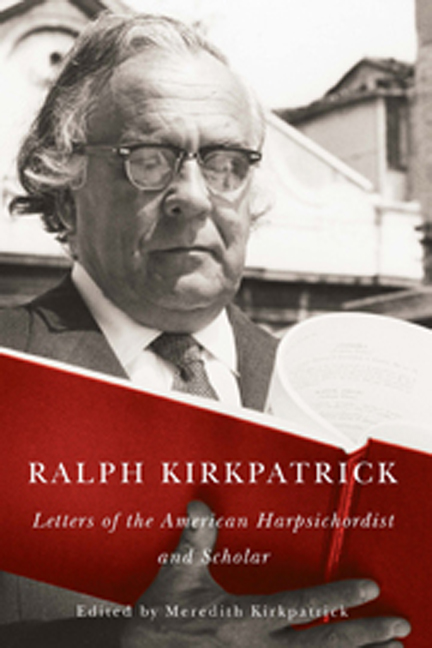Book contents
- Frontmatter
- CONTENTS
- Foreword: “The Glowing of Such Fire”—A Tribute to Ralph Kirkpatrick
- Acknowledgments
- Introduction
- Part One Family
- Part Two Friends, Colleagues, and Other Correspondence
- 2 Nadia Boulanger
- 3 Alexander Mackay-Smith
- 4 Wanda Landowska
- 5 John Challis
- 6 Serge Koussevitzky
- 7 Oliver Strunk
- 8 Roger Sessions
- 9 Harold Spivacke
- 10 Steinway & Sons
- 11 New York Times
- 12 Elizabeth Sprague Coolidge
- 13 John Kirkpatrick
- 14 Alexander Schneider
- 15 Otto Luening
- 16 Donald Boalch
- 17 John Hamilton
- 18 Thornton Wilder
- 19 Lincoln Kirstein
- 20 Arthur Mendel
- 21 Edward Steuremann
- 22 Frank Martin
- 23 Olin Downes
- 24 Albert Fuller
- 25 Elliott Carter
- 26 Quincy Porter
- 27 Vincent Persichetti
- 28 Henry Cowell
- 29 Mel Powell
- 30 Bengt Hambraeus
- 31 Alec Hodson
- 32 Paul Fromm
- 33 Wolfgang Zuckermann
- 34 Kenneth Gilbert
- 35 Mr. and Mrs. George Young
- 36 Colin Tilney
- 37 Oliver Daniel
- 38 Eliot Fisk
- 39 Wilton Dillon
- 40 William Dowd
- 41 Meredith Kirkpatrick
- Afterword: Lessons with Kirkpatrick
- Appendixes
Afterword: Lessons with Kirkpatrick
from Part Two - Friends, Colleagues, and Other Correspondence
Published online by Cambridge University Press: 05 December 2014
- Frontmatter
- CONTENTS
- Foreword: “The Glowing of Such Fire”—A Tribute to Ralph Kirkpatrick
- Acknowledgments
- Introduction
- Part One Family
- Part Two Friends, Colleagues, and Other Correspondence
- 2 Nadia Boulanger
- 3 Alexander Mackay-Smith
- 4 Wanda Landowska
- 5 John Challis
- 6 Serge Koussevitzky
- 7 Oliver Strunk
- 8 Roger Sessions
- 9 Harold Spivacke
- 10 Steinway & Sons
- 11 New York Times
- 12 Elizabeth Sprague Coolidge
- 13 John Kirkpatrick
- 14 Alexander Schneider
- 15 Otto Luening
- 16 Donald Boalch
- 17 John Hamilton
- 18 Thornton Wilder
- 19 Lincoln Kirstein
- 20 Arthur Mendel
- 21 Edward Steuremann
- 22 Frank Martin
- 23 Olin Downes
- 24 Albert Fuller
- 25 Elliott Carter
- 26 Quincy Porter
- 27 Vincent Persichetti
- 28 Henry Cowell
- 29 Mel Powell
- 30 Bengt Hambraeus
- 31 Alec Hodson
- 32 Paul Fromm
- 33 Wolfgang Zuckermann
- 34 Kenneth Gilbert
- 35 Mr. and Mrs. George Young
- 36 Colin Tilney
- 37 Oliver Daniel
- 38 Eliot Fisk
- 39 Wilton Dillon
- 40 William Dowd
- 41 Meredith Kirkpatrick
- Afterword: Lessons with Kirkpatrick
- Appendixes
Summary
I first heard Ralph Kirkpatrick play in 1961. It was also the first time I had heard the harpsichord live and up close. Both were life-changing experiences. Up to that point, I was a fire-breathing, gung-ho, New York City pianist who wanted nothing more than to play Liszt and Rachmaninoff like Horowitz or Byron Janis. But after hearing Kirkpatrick play Bach on the harpsichord, I decided to make a 180-degree turn and devote myself to the instrument and its music.
I needed a harpsichord teacher to get me started, of course, and I was lucky to find an excellent one in New York: Louis Bagger, who taught me so much about articulation, color, and the instrument's expressive potential. It was only later that I learned he had worked with Kirkpatrick. Now that I had a good teacher, I needed a good harpsichord to practice on, and here, too, I was lucky to make the right choice: the not-yet-famous harpsichord builder William Hyman, who made a Flemish model for me in 1964 that would still pass today's standards for historical instruments. For a short time I even worked in his shop, which at that point was in the basement of his parent's house in Queens, to learn a little bit about how the harpsichord was actually made.
After graduating from Brooklyn College in 1968 and taking five years of private lessons with Bagger, I knew it was time for more training on the harpsichord, not to mention widening my musical horizons. I also knew there was only one person who could provide these—Kirkpatrick—so I applied to study with him at the Yale School of Music. I arrived in New Haven on a gray day in November 1968, taking a Trailways bus from New York City to the small Grove Street terminal (no longer there), and walked the few blocks to 15 Hillhouse Avenue (then and now the Yale Collection of Musical Instruments), where Kirkpatrick taught at that time.
- Type
- Chapter
- Information
- Ralph KirkpatrickLetters of the American Harpsichordist and Scholar, pp. 155 - 162Publisher: Boydell & BrewerPrint publication year: 2014



